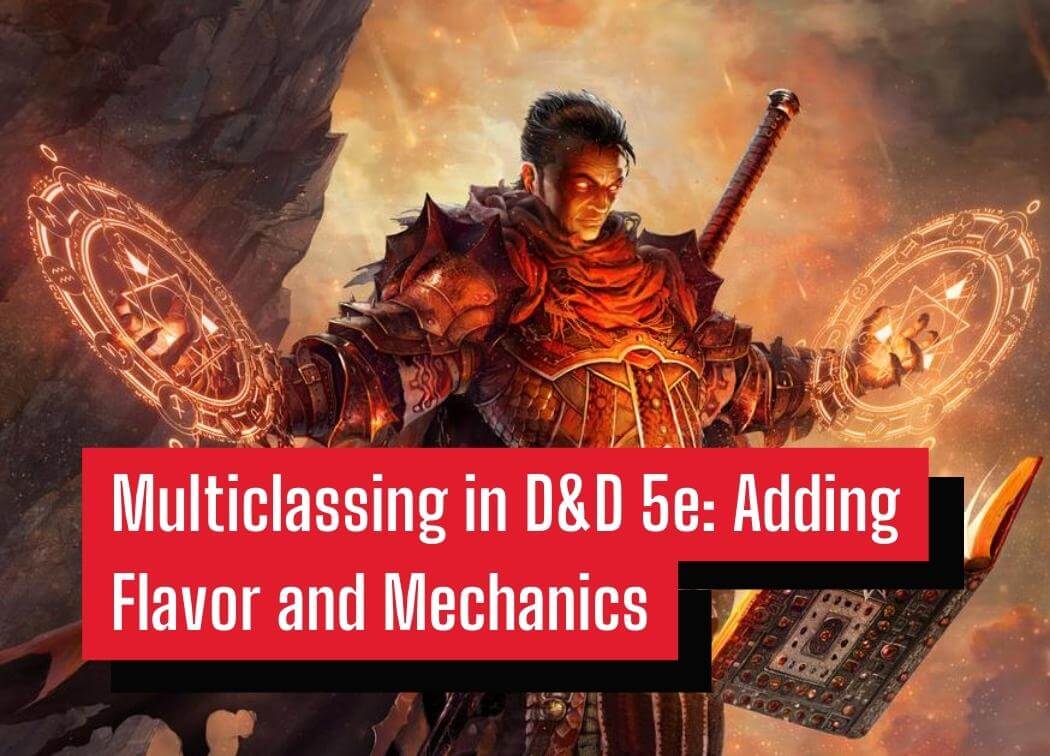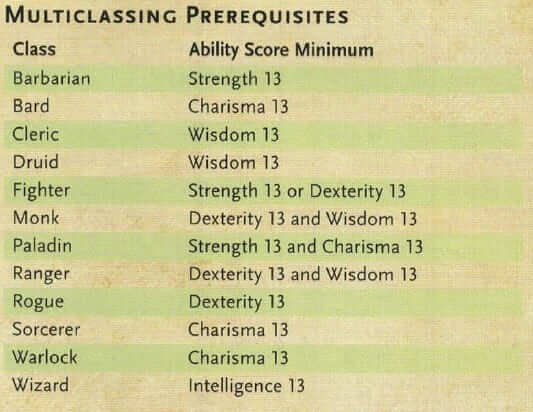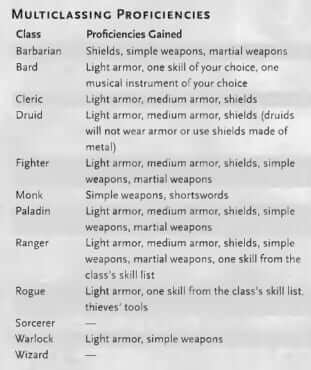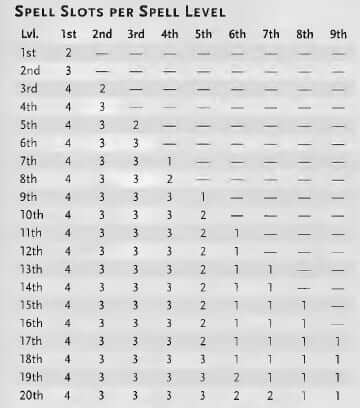Multiclassing in D&D 5e: Adding Flavor and Mechanics

Many times people turn to homebrew content to find the a new class or archetype that adds the right flavor for the character they have in mind. There’s nothing wrong with this, and often times it’s extremely fun.
The downside of homebrew is that it’s not allowed in adventure league games and it’s more likely to be unbalanced compared to its counterparts from the source materials. Another way to add flavor and new mechanics to your character that circumvents both of these issues is by multiclassing.
You can add a ton of great flavor and build a unique character by dipping a few levels into a different class than your PC originally started with. Some multiclass builds may add ways to optimize your character for combat or out of combat encounters. Other builds may be purely for flavor, or to help create a theme for your character.
What is Multiclassing?
Multiclassing is just as the name implies. It is having a character that has levels in more than a single class. This can give a character access to unique class abilities as well as new spell slots and proficiencies. There are classes that have a lot of synergy with each other and multiclassing is a way to take full advantage of it.
Unlike some earlier D&D editions, 5e does not penalize the character for multiclassing. Your character’s proficiency and experience are tied to your character’s total level so they will continue to progress at the same rate as the rest of the party.
Still, this does come with the trade-off of sacrificing your level 20 class feature, but I don’t find this to be a big issue. First of all, it’s extremely rare to be in a campaign that naturally progresses to level 20. In addition to that, depending on the class you chose, your level 20 feature may not even be all that great. These are still things to keep in mind, but typically I wouldn’t let your level 20 feature be a reason to stay out of multiclassing.
Prerequisites for Multiclassing
These prerequisites come in the form of having at least a 13 in the primary ability score(s) of each class you will be multiclassing into as well as your starting class. For example, multiclassing into Wizard requires at least an intelligence score of 13 and you must have a strength or dexterity score of 13 to satisfy the requirement of your current class, fighter. I’ve added the full table of prerequisites below.

However, by the rules your only requirement is to have at least 13 in the ability score(s) of your new class(es) and your original level 1 class. This is a pretty easy prerequisite to pass which makes multiclassing fairly painless in 5th edition. There is no limit to the amount of classes you can multiclass into. As long as you meet the prerequisites you can take at least 1 level in the class.
Some DMs may have homebrew rules for multiclassing so it’s best to check with them first. They may want you to have an in-game reason for your character to seek training in a new class. Personally, I think you should have a reasoning for this regardless of it being a requirement or not. It adds both development and depth to your character!
Multiclassing for Flavor
One of the primary reasons people make multiclass characters is to add some new flavor to their character. Maybe your character is getting stale and you want to create something more interesting. Conversely, you may have an idea in mind for a character that requires some mechanics from another class for the idea to come to life. Whatever it may be, multiclassing is an excellent way to add some new elements into your game.
Here are some of my favorite examples of how multiclassing can be used to add some flavor to a character.
Adding Magic
Giving a martial character access to magic is a great way to expand on the flavor of your character. Having access to cantrips and spells adds so much in the game both in the form of RP and combat encounters. Even if it’s just a few levels, a dip into a magic user class can add a ton of new elements to your martial character.
Perhaps a party member is mentoring your character in the arcane or divine. Maybe your player was inspired to study magic to expand their horizons. Magic in D&D leads way to plenty of character development and interactions, both of these you can take advantage of to make a unique character.
Adding Martial Prowess
Just like adding a magic class to a martial character build, the converse is also true. You can create a character that’s a bit heftier and able to stay on the front lines of the battlefield. Dipping a few levels into rogue could give you an assassin or thief element to your traditional spellcaster class.
One hook is that your magic using character didn’t want to have to rely on their god or their innate abilities to survive the adventuring life. They’ve began training and becoming more physically gifted in order to meet their goals as they don’t believe magic is the solution for all of their problems.
Conflicted Power
Using two classes together that have opposing viewpoints or flavor can create a very unique character. There are plenty of examples of this such as the classic paladin/warlock combination. The paladin may take power from a patron to help aid them in keeping their oath. However, this might create a conflict depending on what that paladin’s oath is.
There are plenty of combinations like this that may create an inner conflict for your character. This can be a fun way to explore the inner workings of your character and really stretch their morals.
Multiclassing for Optimization
The other major reason for multiclassing is to create a more optimized character. This may be a general optimization interest or a way to really carve out a niche for a character. It’s also a great way to optimize the party overall if your party composition is missing something. Whatever it may be, having a multiclassed character is a great way to tackle any of these potential facets of the game.
Proficiencies
When you pick your starting class you gain your skill, weapon, and armor proficiencies. These are generally set-in-stone depending on the class you chose, your feat options, and your DM’s rules on gaining new proficiencies. However, one way to quickly gain some nice proficiencies is to multiclass into a class that will give you these bonuses.
Each class gives a different set of proficiencies for dipping into it for a level. This can make some options much more desirable than others due to their proficiencies they’d grant you. There are even a few that will give you an additional skill which can come in handy for a character that is looking to cover a wide base of skills.

One great example of how these proficiencies can be extremely powerful is that as a wizard or sorcerer you cannot wear armor. If you were to take a level in any class you’d gain either armor proficiency or the unarmored bonuses from their respective classes. This can give your wizard or sorcerer some much-needed AC and survivability while also giving them a new skill or weapons proficiency. Cleric is actually an excellent class for these two to multiclass into as it gives them access to heavy armor through some of their archetype choices.
These bonus proficiencies are in addition to the regular abilities and perks of taking levels in that class. The downside to all this is that each class only gives some of the proficiencies you’d have gained by taking the class at level 1. This is a big reason as to why your starting class is one of your biggest decisions as a player. In many cases the perks you gain from one will outweigh the other.
Spell Slots
Spell slots is where multiclassing gets a bit tricky. You’ll need to take all of your individual class levels and add them together to determine your spell level. Full-casters (bard, cleric, druid, sorcerer, and wizard) count a 1 level. Half-casters (paladins and rangers) count as 1/2 of a level rounded down. Characters that gain spellcasting through an archetype like eldritch knights and arcane tricksters will count as 1/3 of a level rounded down.
Once you have the sum of your levels consult the table below this paragraph. This will be how many spell slots you have to use with your combined levels. Pact magic from warlocks is an exception to the rule and one of the reasons why warlock is such a powerful multiclassing option for many character builds.

For example, a character that is 5 wizard/5 ranger would be a spell level of 7. Technically you are at spell level 7.5, but since we round down when determining spell level you’ll miss out on those level 8 spell slots until your next level in a full or half-caster class.
As an added note, your spells known/prepared do not change when multiclassing. You will gain the normal amount of spells in each class which makes multiclassing into different caster classes a viable option to gaining more spell options. That being said, you will lose out on learning more powerful spells, or at least you will be learning them much later than you normally would.
Synergistic Mechanics
There are many classes that work well together. Builds like dexterity-focused fighters with some levels in rogue or a paladin with a couple of hexblade warlock levels can really pack a punch in the battlefield. Dipping a few levels into a spellcasting class can not only bring your character some more flavor but also some awesome optimizations in the form of cantrips and low-level spells.
You’ll notice that in both of these examples I’ve chosen characters that share at least one main ability score. That’s the real key to finding synergistic classes to multiclass together. When creating an optimal multiclassed character you’ll want to ensure that you won’t need to spread your ability score increases too thin as you will be getting less of those overall.
There are tons of combinations that you can choose from given the plethora of different archetypes. Finding a couple that works very well together to give yourself an edge in or out of combat can be key for optimizing your character to the best of their ability. There are also some classes and archetypes that work really, really well with tons of different builds such as the hexblade warlock or a sorcerer.
Conclusions
Be it adding some depth and RP flavor or creating a niche for your character multiclassing can be a valuable asset in character creation. It lets you cherry-pick some neat skills, abilities, and spells from other classes and add them to your own. It’s a great way to build a completely different character to fit an intended theme without relying on homebrew options.
Personally, I was pretty hesitant to try out multiclassing at first. It’s tough to give up your higher spell levels and abilities. However, you’re doing so to give your character a lot more variety which can sometimes be more powerful than what a single class can provide.
It may also unlock some really powerful synergies like with my arcane archer fighter dipping into 3 levels of assassin rogue for the assassinate ability.
For more information on multiclassing check out pages 163-165 of the Player’s Handbook!

Liked the article, like you i was originally cautious about multiclassing. But after giving it a try and really think about it, almost all of my characters will probably multiclass.
One thing though. You need to meet the prereqs for both your orginal class and the new class, not just the new one. No cheese 8 wisdom lvl2 druid lvl 18 barbarians
Absolutely! It opens up so many new possibilities, but it is hard to initially get over that fear of missing out on the higher level features of sticking with a single class.
I just updated the article to reflect this. Thank you so much! I totally missed that originally, so I appreciate the correction!